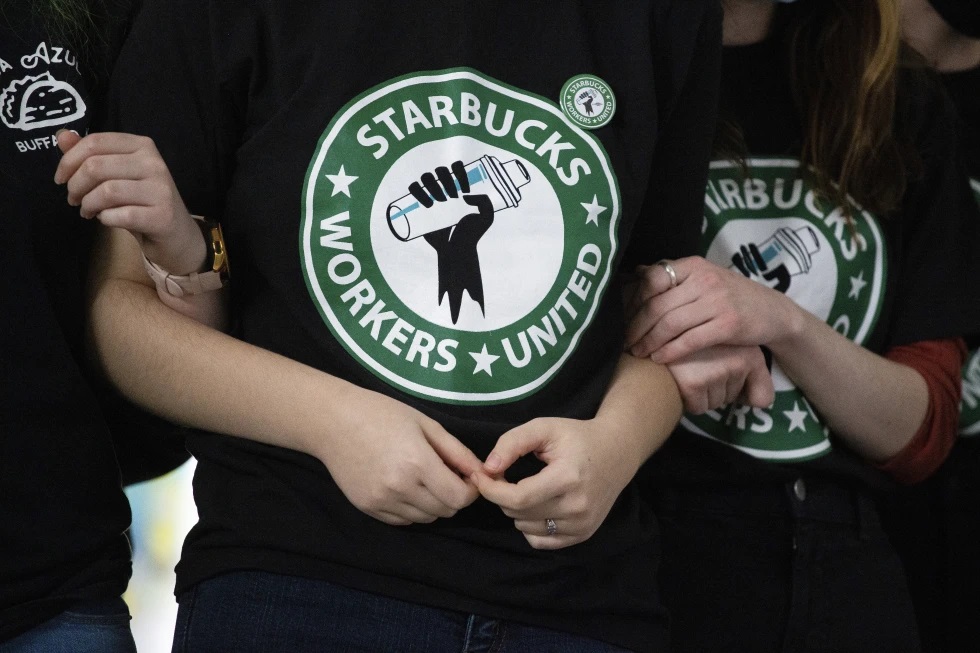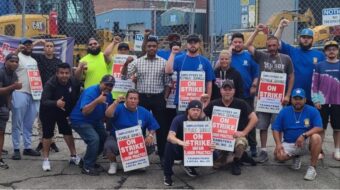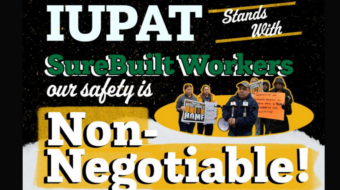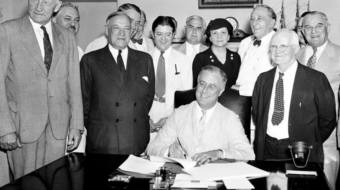
WASHINGTON—The ever-growing Starbucks unionization campaign—now up to 420 wins and counting—and the power of the National Labor Relations Board to punish employers, like Starbucks, who break labor law and defy its orders hit the U.S. Supreme Court on April 23. And Starbucks is trying its hardest to further weaken the board.
At issue was Starbucks’s challenge to one of the NLRB’s strongest “sticks” against a lawless boss, the 10(j) preliminary injunction. The board seeks such court orders only in extreme cases of labor law-breaking when its normal sanctions won’t work.
Those “normal” penalties are mild: Orders to rehire fired workers and make them financially whole, to recognize and bargain with the union, and/or to post or read a we-won’t-do-it-again notice.
The board also seeks injunctions when the harm to the workers involved, in this case, the “Memphis 7” Starbucks workers, is both immediate and irreparable. Starbucks fired the workers, most of them people of color, for giving interviews to the media about their organizing drive there—outside their store and after hours.
The NLRB went to federal court when Starbucks wouldn’t settle the case. The board sought and got the preliminary injunction making the workers whole by taking them back with back pay, immediately, using two new standards which, the company claims, make it easier for the board to head to court.
Starbucks, subject of a dozen nationwide injunctions already for its labor law-breaking during the workers’ organizing drive, wants to go back to the old injunction rules, which imposed a tough four-part test for the agency to pass before it could go to court in the first place.
Under that test, the NLRB sought only 21 injunctions nationwide in fiscal 2022, the last data available, and won 14 of them. “This is not sounding like a huge problem,” Justice Ketanji Brown Jackson commented.
The lack of injunctions, along with employer intimidation, firings, spying, lies, closure threats, and other labor law-breaking—in Memphis, Starbucks did close the store—could chill further union organizing, Justice Amy Coney Barrett asked Starbucks attorney Lisa Blatt. Blatt agreed it could.
Would make it easier
Left unsaid in the High Court’s session was that the Protect the Right to Organize (PRO) Act, labor’s top legislative priority, would not only make seeking injunctions easier but would also order the board to reinstate the harmed workers immediately, even if the bosses appealed the injunctions to the courts. That’s one of many PRO Act reforms to level the labor law playing field.
“Preliminary injunctions are extraordinary and drastic remedies,” Blatt told the justices during oral argument. “Here, the board seeks a coercive injunction backed by contempt sanctions, and the board seeks the very same injunctive relief that it would get if it won the case.”
“Why would the board get deference when the board doesn’t deserve any deference and has no expertise on how equity should be weighed?” Blatt asked when Justice Ketanji Brown Jackson challenged her.
The right-wing justices, except for Justice Barrett, and one comment from Justice Neil Gorsuch, asked no questions at all. But in the past, Justices Clarence Thomas and especially Samuel Alito have been particularly hostile to unions.
And Justice Gorsuch is the court’s chief crusader against retaining rule-making power with federal agencies—including the NLRB—which have expertise in the issues involved. He wants to turn it over to Congress or the courts.
Justice Department attorney Austin Raynor defended the board. Raynor got right to the heart of the matter. He said that without the potential stick of a 10(j) injunction, the board would be so weak that its powerlessness would chill union organizing drives.
“Not all unlawful discharges necessarily show irreparable harm” to the workers, said Raynor. “The question the board looks at and the question we think the court should look at is whether that extinguishes the momentum of the union drive or impairs it in such a serious way that an order from the board a year or two down the road won’t be able to restart the drive.”
And since corporate greed is a reason Starbucks strenuously resists unionizing, Raynor cited it, too.
“In a run-of-the-mine case, there’s only going to be purely private profit–profit motive interests on the other side–injunctive relief is typically going to be warranted,” he said.
“This is an expert agency that has said we think these are the most deserving of relief,” Raynor told Chief Justice John Roberts. “As Justice Jackson was mentioning earlier, this isn’t a case where the board has engaged in abuse or bringing all sorts of claims before courts. It’s been highly selective.”
“I don’t know why the inference isn’t the exact opposite, that these are the” labor law-breaking cases “you really feel that you’ve got to put, you know, the best behind them because these are the ones that are going to end up in court, the ones that are most vulnerable.”
“But the function of the Section 10(j) position, Mr. Chief Justice, is to preserve the board’s remedial authority” to solve the ultimate case and make the workers whole after company labor law-breaking. “So these are the cases where the Board is worried about irreparable harm accruing before the board can issue its decision.”
Sided with the NLRB
In friend-of-the-court briefs, 12 former Starbucks Workers, all of them disciplined and most of them fired for supporting unionizing, sided with the NLRB. Their friend-of-the-court brief told the justices what it’s really like after Starbucks fires you—and after its bosses use the board and the courts to delay and sometimes deny justice.
“Starbucks has committed more than 400 violations of federal labor law, including firing 59 union leaders and supporters, according to decisions of administrative law judges,” the brief for the fired workers says. “More than 60 additional complaints against Starbucks are awaiting decisions.”
The workers “suffered grave harm from Starbucks’s illegal retaliation. Several had to rely on public assistance or the help of family members to pay bills and buy food. They lost their health insurance coverage and struggled to pay medical bills, sometimes deferring care.
“One of them could no longer support her children, who had to move out of her home. Another began skipping meals and was unable to pay bills to the electric company, leading to the loss of electricity—and thus heat–in her apartment. The mental toll led several to struggle with depression, anxiety, and panic attacks. For some, this manifested in thoughts of suicide and self-harm. One was hospitalized as a result.”
“Many of the harmed workers “are still awaiting a remedy for Starbucks’s conduct—even after findings of unlawful conduct, issued after full trials. This is due to the slow pace of unfair labor practice cases.”
By contrast, Starbucks painted a rosy picture boasting of its good working conditions, the workers noted. It conveniently overlooked that one of the dozen baristas filing that friend-of-the-court brief was JaysIn Saxton, of Augusta, Ga. He has some experience in Starbucks’s gap between rosy and reality.
When Starbucks then recently retired CEO and chief shareholder Howard Schultz made the same rosy claims, under oath, to the Senate Labor Committee, Saxton, a military veteran, was one of two baristas to follow him to the witness chair and call out his lies.
Saxton won his case before the NLRB—without an injunction—and walked back into the Augusta Starbucks store, but has since left the company “because it didn’t give him sufficient hours of work” to make a living and feed his family, the workers’ brief said.
“In light of the multi-step NLRB process, Congress knew effective interim relief was critical. Thus, Congress authored Section 10(j) to provide interim relief” while harmed workers waited…and waited…and waited for a final decision.
“Courts universally recognize section 10(j) is designed to protect the public interest in preserving labor peace through the process designed by Congress, not to vindicate private rights,” the AFL-CIO’s brief said.
“They look then to whether there is an ongoing harm that, if allowed to continue, could not be fully remedied by any eventual remedial order from the board. By its nature, such harm would have no adequate remedy at law, and an injunction to stop it would be in the public interest.
“At bottom then, Starbucks’ complaint is one of semantics. Whichever “analysis a court applies, each” is focusing on furthering the purposes of” the National Labor Relations Act. “This is demonstrated by the lower court’s application of the two-part test in this case. The district court found the board presented compelling evidence the seven baristas were fired for their union activity.”
We hope you appreciated this article. At People’s World, we believe news and information should be free and accessible to all, but we need your help. Our journalism is free of corporate influence and paywalls because we are totally reader-supported. Only you, our readers and supporters, make this possible. If you enjoy reading People’s World and the stories we bring you, please support our work by donating or becoming a monthly sustainer today. Thank you!










